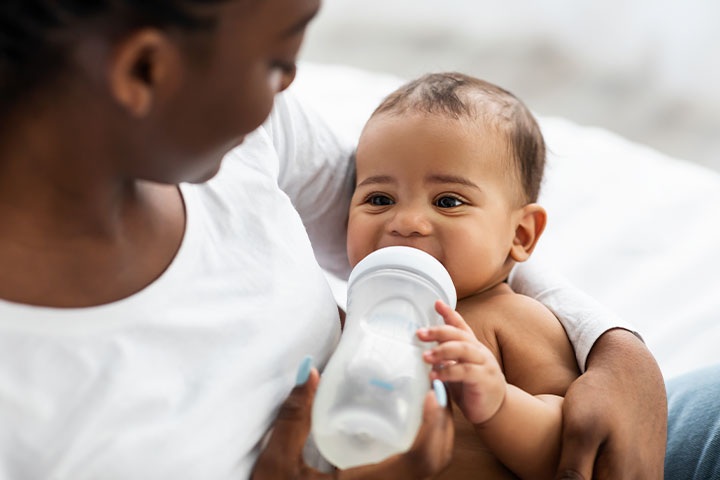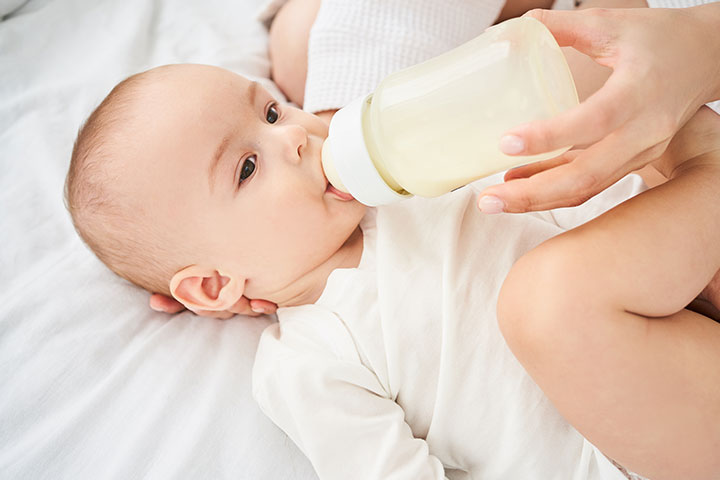
Image: Shutterstock
As parents, you may have heard about the magic of paced bottle feeding when it comes to giving your little one the best mealtime experience. But what is it exactly, and why is everyone talking about it? Let’s delve into the wonderful world of paced bottle feeding together. Read on to know more!
What Is Paced Bottle Feeding?
Paced bottle feeding mirrors the natural rhythm of breastfeeding, creating a gentle, synchronized interaction between you and your baby. It’s a method where you guide the feeding pace, allowing your little one to control the flow, similar to breastfeeding. Rather than simply filling up your baby’s tummy, it prioritizes a calm and comfortable feeding experience that matches the natural pace of nursing.
Imagine a feeding style where breaks and pauses align with your baby’s cues, just like during breastfeeding. By controlling the bottle’s angle to manage the flow, you create a comforting nursing environment. Paced bottle feeding isn’t solely about nourishment — it’s about fostering a close connection between you and your baby during feeding time while ensuring they feel satisfied and content.
The Steps In Paced Bottle Feeding
Image: Shutterstock
1. Settle in Comfortably
Find a cozy, distraction-free spot where you and your baby can relax without interruptions. It could be a comfy chair or a quiet corner where you both feel at ease.
2. Positioning Is Key
Hold your baby in a semi-upright position, supporting their head and neck while cradling them close to your body. This position helps prevent choking and allows for a more comfortable feeding experience.
3. Introduce The Bottle
Offer the bottle to your baby and allow them the time to latch onto the nipple comfortably. Ensure the nipple is filled with milk and angled to control the flow, but not tilted too far to avoid overwhelming them.
4. Follow Their Lead
Let your baby dictate the pace of feeding. Watch for cues such as sucking, pausing, or turning away from the bottle. These are indications that they may need a break or that they’re feeling full.
5. Embrace Breaks
Pause frequently during the feeding session, mimicking the natural breaks a baby takes while breastfeeding. This allows your baby to rest, burp, or indicate they’ve had enough, promoting a more relaxed and satisfying feeding experience.
What Are Its Benefits?
1. Prevents Overfeeding
By allowing the baby to control the pace, paced bottle feeding minimizes the risk of overfeeding, ensuring they consume just the right amount.
2. Reduces Gas And Spit-Up
The slower flow helps in reducing air intake, decreasing the chances of gas discomfort and excessive spit-up.
3. Enhances Bonding
Paced feeding creates a more intimate and engaging feeding experience, strengthening the emotional bond between the caregiver and the baby.
4. Develops Hunger Awareness
It encourages the baby to recognize their hunger and fullness cues, aiding in developing self-regulation around feeding.
What You Need For Paced Bottle Feeding
Image: Shutterstock
To embark on the paced bottle feeding journey, ensure you have the right tools at hand. Opt for a slow-flow nipple designed specifically to control the milk flow, allowing for a more manageable pace during feeding sessions. Selecting a bottle that mimics the breast shape can aid in easy latching, providing a familiar feel for your baby and promoting a more natural feeding experience.
Equally important to the equipment is your mindset and approach. Patience becomes your ally during paced bottle feeding. It’s not just about the physical tools; it’s about the gentle, patient approach you bring to each feeding session. Love, of course, forms the foundation of this nurturing interaction, fostering a warm and comforting environment that makes feeding time a bonding experience between you and your baby. So, gather your equipment and infuse the process with heaps of patience and love to make paced bottle feeding a fulfilling and enjoyable journey for both you and your little one.
When To Stop
Recognizing when your baby has had enough during paced bottle feeding involves observing cues like turning away from the bottle, slowing down sucking, or losing interest. These signs indicate possible fullness, signaling it’s time to pause the feeding session. Additionally, if your baby appears content and relaxed post-feeding, it’s a good indicator they’ve had sufficient nourishment for the moment. Trusting these cues helps your baby learn to recognize and respond to their body’s needs, fostering a healthy feeding relationship.
Understanding your baby’s cues is key to concluding a paced bottle feeding session. Signs like turning away, slowing down, or displaying disinterest indicate potential fullness, signaling it’s time to pause. Similarly, if your baby seems content and relaxed after feeding, it suggests they’ve likely had enough. Respecting these cues nurtures a healthy feeding dynamic, allowing your baby to develop their self-regulation around hunger and fullness.
In a nutshell, paced bottle feeding is all about finding balance and harmony during feeding time. It’s about nurturing not just your baby’s tummy but also their connection with you. So, grab that bottle, snuggle up with your little bundle of joy, and let the paced bottle feeding magic begin!














